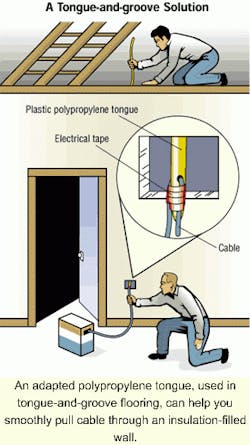Ashton Wood / Optus Communications
problem
Cabling can be difficult to run at the best of times-but what happens when you drill a hole in a plaster wall with the intention of running a cable from the roof cavity down to this hole and find it filled with insulation?
We all know how "cable rods" make life easier, but they are designed with a straight cable run in mind (like along a cable tray, etc.) and won't bend to go inside a wall cavity. A "mouse" (string and chain) is also very useful but will stop in its tracks at insulation.
solution
Plastic (polypropylene) tongue! This tongue is used in particle flooring as the tongue-and-groove mechanism-it is quite difficult to buy, but may be found at building sites where particle flooring is used. The tongue is about 15 millimeters (1/2 inch) wide, 3 millimeters (1/10 inch) thick, and 3.6 meters (12 feet) long.
procedure
- Find a length of the tongue at a building site or flooring contractor.
- Round off both square cut ends of the tongue with a file to form a blunt point.
- Drill a small hole (about 2/10 inch) in both ends of the tongue to enable a cable to be looped through.
- Push the tongue into the wall and feed it through until it appears at the other end.
- Connect the wire to the tongue by passing it through the hole in the end of the tongue, and then folding it back on itself-a little bit of electrical tape around the wire wouldn't hurt as there is nothing worse than losing that wire in the middle of the wall.
- With the wire attached, pull the tongue completely through from the far end, and you have your wire.
- The tongue will soon become your favorite tool and will last you for years to come.
Ashton Wood is an engineer in the transmission operations group with Optus Communications, North Sydney, NSW, Australia. This tip was supplied to our sister publication, Cabling Installation & Maintenance Australia-New Zealand.
Cash for your Tips!
We need your Installer Tip ideas! We'll pay you $50 for each idea that we publish as an Installer Tip. It's easy - just send us a few words describing the problem and your solution. If we like it, we'll call you for more details and do all the writing. To submit an idea, contact
Patrick McLaughlin, at tel: (603) 891-9222, fax: (603) 891-0587, e-mail: [email protected].

